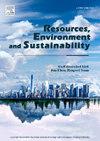Carbon footprint of immunocastrated male fattening pigs compared to entire males, gilts, and surgically castrated males
IF 12.4
Q1 ENVIRONMENTAL SCIENCES
引用次数: 0
Abstract
Efforts to minimize the environmental impact of livestock production are essential for sustainable agriculture. Immunocastration, using products like Improvac®, offers an alternative to surgical castration, enabling the physiological advantages of rearing entire male pigs while addressing issues such as boar taint and animal welfare. This review analyzes the effects of immunocastration on the performance and carbon footprint of fattening pigs compared to entire males, gilts, and surgically castrated males. Data from 39 trials reported in research articles were used to extract information on average daily gain (ADG), feed conversion ratio (FCR), and mortality. The means of these parameters were used to calculate the carbon footprint. Results showed that immunocastrated males had a higher mean ADG and a lower mean FCR compared to gilts and surgically castrated males, resulting in 7.1% and 6.8% lower carbon footprints, respectively. However, entire males had a slightly lower carbon footprint than immunocastrated males due to a more favorable FCR, although differences were not statistically significant. The findings underscore the ecological advantage of immunocastration over surgical castration, driven by improved feed efficiency and growth rates. From a sustainability perspective, boar fattening offers the lowest environmental impact, but practical challenges like boar taint and behavioral issues remain. If boar fattening is not feasible, immunocastration emerges as the preferable alternative to surgical castration, aligning with ecological and animal welfare goals. This review highlights the potential of immunocastration to balance productivity and sustainability in fattening pigs while addressing consumer and regulatory concerns.

免疫阉割的育肥猪与全公猪、后备猪和手术阉割的公猪的碳足迹
努力尽量减少畜牧生产对环境的影响对可持续农业至关重要。免疫阉割,使用像Improvac®这样的产品,提供了手术阉割的另一种选择,在解决公猪污染和动物福利等问题的同时,实现了整只雄性猪的生理优势。本文分析了免疫阉割对育肥猪生产性能和碳足迹的影响,并与全公猪、后备猪和手术阉割的公猪进行了比较。利用研究文章中报道的39项试验的数据提取平均日增重(ADG)、饲料系数(FCR)和死亡率的信息。利用这些参数的均值来计算碳足迹。结果表明,与后备母猪和手术阉割的雄性相比,免疫阉割的雄性平均平均日增重更高,平均FCR更低,碳足迹分别降低7.1%和6.8%。然而,由于更有利的FCR,整个雄性的碳足迹略低于免疫阉割的雄性,尽管差异没有统计学意义。研究结果强调了免疫去势优于手术去势的生态优势,其驱动因素是饲料效率和生长率的提高。从可持续发展的角度来看,养猪对环境的影响最小,但像猪污染和行为问题这样的实际挑战仍然存在。如果公猪育肥不可行,免疫阉割成为手术阉割的首选选择,符合生态和动物福利目标。本综述强调了免疫阉割在平衡育肥猪生产力和可持续性方面的潜力,同时解决了消费者和监管方面的问题。
本文章由计算机程序翻译,如有差异,请以英文原文为准。
求助全文
约1分钟内获得全文
求助全文
来源期刊

Resources Environment and Sustainability
Environmental Science-Environmental Science (miscellaneous)
CiteScore
15.10
自引率
0.00%
发文量
41
审稿时长
33 days
 求助内容:
求助内容: 应助结果提醒方式:
应助结果提醒方式:


